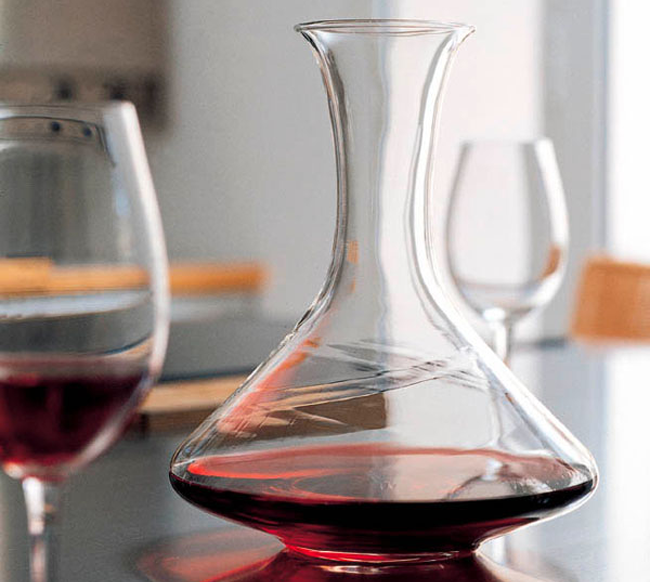“Wine is a living liquid containing no preservatives. Its life cycle comprises youth, maturity, old age, and death. When not treated with reasonable respect it will sicken and die.”
– attributed to the late Julia Child
Decanting and Choosing the Right Wine Glass
Wine, much like life, gets better with a little air and the right perspective—or, in this case, the right glass. Let’s explore the art of decanting and the subtle science of wine glass selection.
Decanting Wine
Decanting wine is really only necessary with older wines to allow them to breathe, potentially improving the flavor of those mature reds. It also helps with wines that have a lot of sediment—you know, the kind that makes you wonder if you’re drinking wine or a DIY sand art project.
If the wine has been upright for a while, you can pour it into the decanter straight away. If not, let the bottle stand upright for a short time to let the sediment sink to the bottom of the bottle. Slowly pour the wine at an angle into the decanter. If you’re feeling extra fancy (or just cautious), pour the wine through a piece of cheesecloth to catch the sediment—because no one wants to chew their drink.
Younger wines can also be decanted to help with aeration, but let’s face it: decanters are often more for decorative appeal in these cases. I always like to use one when friends are over for dinner—it just looks so much classier.
Types of Wine Glasses
Part of the joy of wine is its color and aroma, so wine glasses should be clear and large enough to let those aromas develop. Try not to fill a glass more than half full—this isn’t bottomless mimosa brunch, after all. The shape of the glass also plays a big role. While there are endless variations, here are the basics:
-
Champagne/Sparkling Wines: A tall, narrow glass helps preserve the bubbles and keeps the sparkle alive—because no one wants champagne that’s fizzled out faster than a bad party.
-
White Wines: A tulip-shaped glass keeps the aroma contained and helps maintain the cooler temperature, ensuring your wine stays crisp and refreshing.
-
Red Wines: A round, bowl-like glass allows the wine to aerate, giving those complex flavors room to shine. Reds are the drama queens of wine—they need their space.
-
Dessert Wines: These glasses are smaller, much like the servings of dessert wine itself. With a higher alcohol content, a little goes a long way—especially if you’re aiming to remain upright.
There are, of course, “all-purpose” wine glasses, like the ones you’ll find at tastings. Fun fact: The ISO (International Organization for Standardization) has standardized a series of tasting glasses designed to concentrate the bouquet. Yes, even wine has an engineering team behind it.
While you can drink white wine out of a red wine glass, doing the opposite is generally frowned upon. Think of it like wearing flip-flops to a black-tie event—it just feels wrong.
A Personal Note on Glassware
At home, I always use one of the three main types of wine glasses (I rarely drink dessert wine—don’t judge me). Some of my friends have laughed at me for insisting they use the correct glass, but to me, it’s non-negotiable. Drinking red wine out of a white wine glass? It’s like playing a violin with a spoon. Sure, it’s possible, but why would you?
So, grab your decanter, pick the right glass, and pour yourself something fabulous. And if anyone gives you grief about being particular, just remind them: it’s not about being fussy—it’s about respecting the wine.
And, finally, but don’s say I said this
Drink your wine out of whatever makes you happy at that moment in time. For me, it can occasionally be a plastic glass filled with Chardonnay on my return flight from Detroit to Chicago.
Source: Wine Spectator









